Are you a photographer looking to monetize your passion? Where can I sell my photos? dfphoto.net is here to help you navigate the world of online photo sales, guiding you to platforms that turn your visual art into income and allowing you to showcase your unique images to those looking to license creative content. Let’s explore the best options for selling your photos, learn how to build a captivating portfolio, and discover tips to boost your earnings, ultimately turning your photography skills into a profitable venture.
1. Best Websites for Selling Photos Online
Selling your photos online can be a rewarding experience, providing both income and recognition. Here’s a breakdown of some of the top platforms available:
1.1. Alamy
Alamy boasts a vast collection of stock photos, videos, and panoramic images, making it a great place to showcase your work.
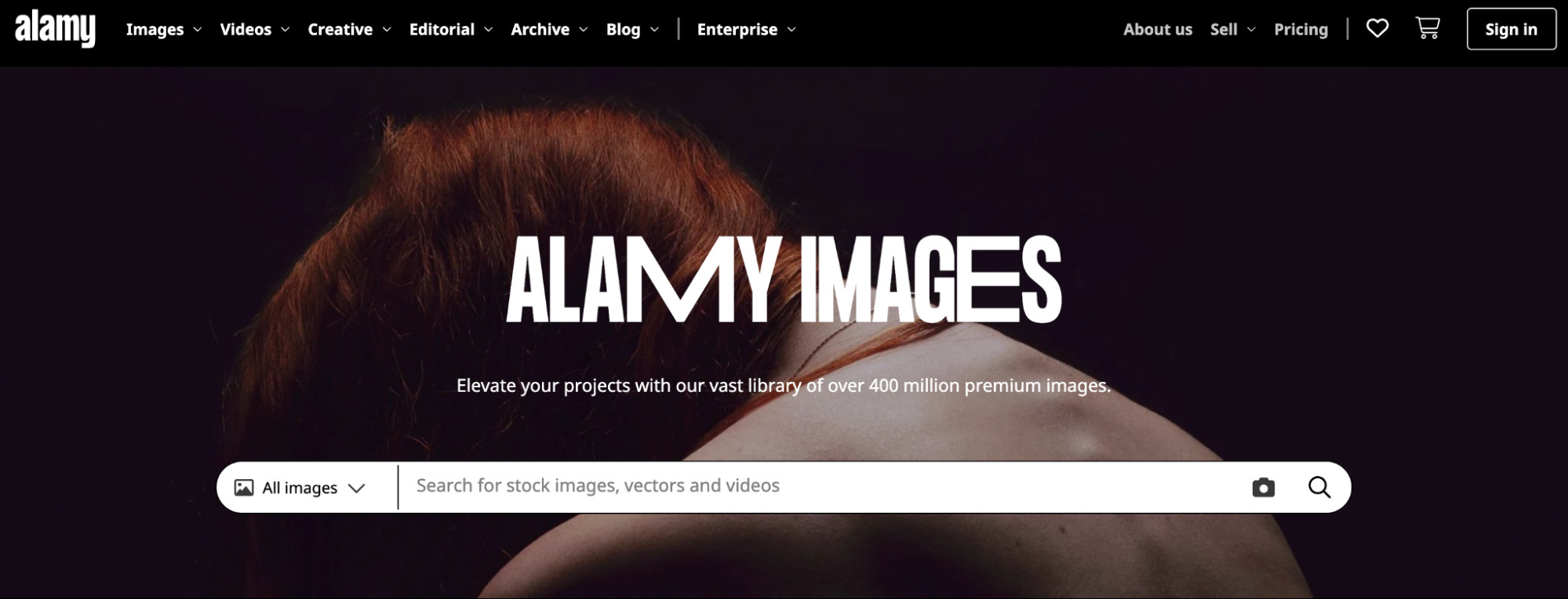 Alamy Images homepage showing a search bar for people to find royalty-free images.
Alamy Images homepage showing a search bar for people to find royalty-free images.
Key features:
- Diverse stock photo collection.
- Stockimo iOS app for selling photos directly from your phone.
How to get paid:
Alamy offers monthly payments and photographers receive between 17% and 50% of sales based on image popularity and license type. According to Alamy, there are no long-term contracts, and payments can be made in multiple currencies.
1.2. 500px
500px combines stock photo licensing with community features. It’s an online community for both amateur and professional photographers.
 500px’s homepage that shows how contributors can get paid for their photos with licensing.
500px’s homepage that shows how contributors can get paid for their photos with licensing.
Key features:
- Pulse algorithm to highlight new photographers.
- Online community for feedback and competitions.
How to get paid:
Members can earn up to 100% royalties for exclusive photos.
1.3. Shutterstock
Shutterstock is a well-known and popular stock photography website.
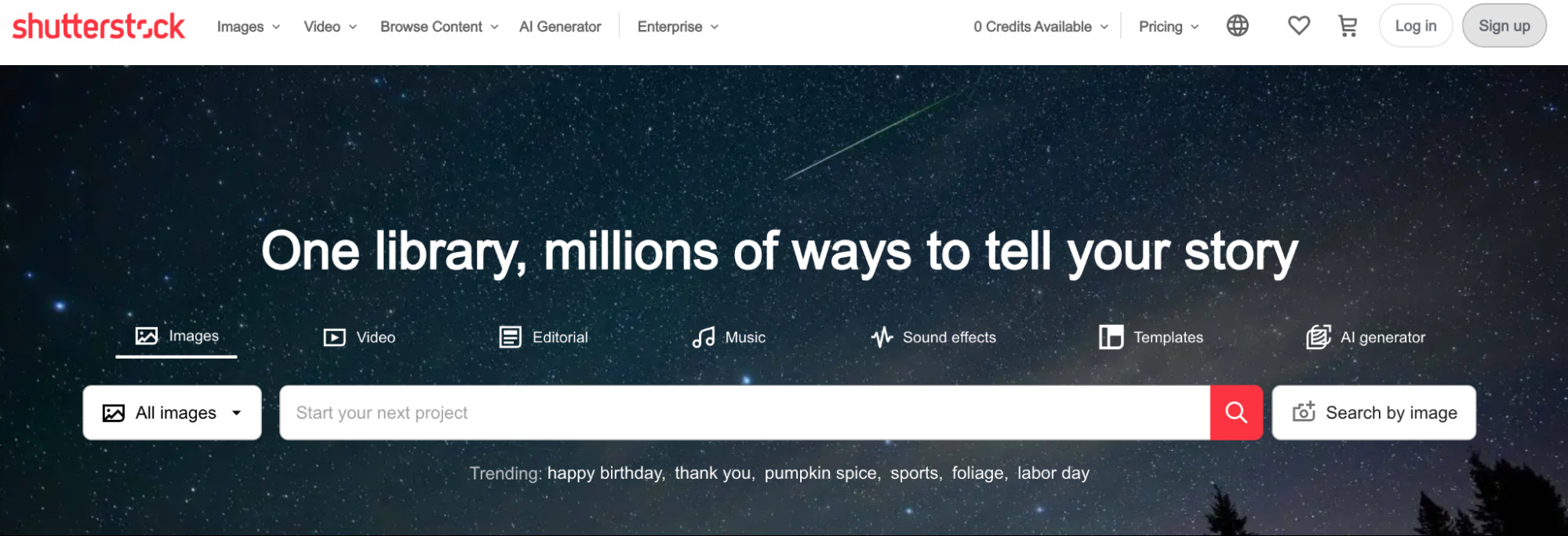 Shutterstock homepage that lets people find royalty-free images, video, and music.
Shutterstock homepage that lets people find royalty-free images, video, and music.
Key features:
- Has paid out over $1 billion to its community.
- Micro-stock site with non-exclusive photos.
How to get paid:
Payouts range from 15% to 40% based on earnings over time. There’s also an affiliate program for additional income.
1.4. Getty Images
Getty Images attracts brands and publishers looking for high-quality, exclusive images.
 Getty Images’ homepage with a search bar that helps people find photos and images.
Getty Images’ homepage with a search bar that helps people find photos and images.
Key features:
- Large library of premium stock photos.
- Strict standards for accepting photography.
How to get paid:
After applying and being accepted, you can be paid between 15% and 45% of an image’s license fee.
1.5. iStock
iStock, an offshoot of Getty Images, allows you to sell non-exclusive photography.
 Landing page for iStock that shows its generative AI-powered image creator.
Landing page for iStock that shows its generative AI-powered image creator.
Key features:
- Photos can be non-exclusive.
- Offshoot of Getty Images.
How to get paid:
Commissions range from 15% to 45%, depending on contributor agreements.
1.6. Stocksy
Stocksy is an artist-owned cooperative that offers high payouts to contributors, making it accessible for newer photographers.
 Stocksy homepage with an art graphic of people in a library.
Stocksy homepage with an art graphic of people in a library.
Key features:
- 50% royalty on standard licenses, 75% on extended licenses.
- Artist-owned cooperative.
How to get paid:
Stocksy pays monthly via PayPal, Payoneer, or check, with a minimum payout of $100.
1.7. Picfair
If you want greater control over your online photo portfolio, Picfair is a great option. You set your own prices and Picfair handles payment processing, print production, shipping, and licenses.
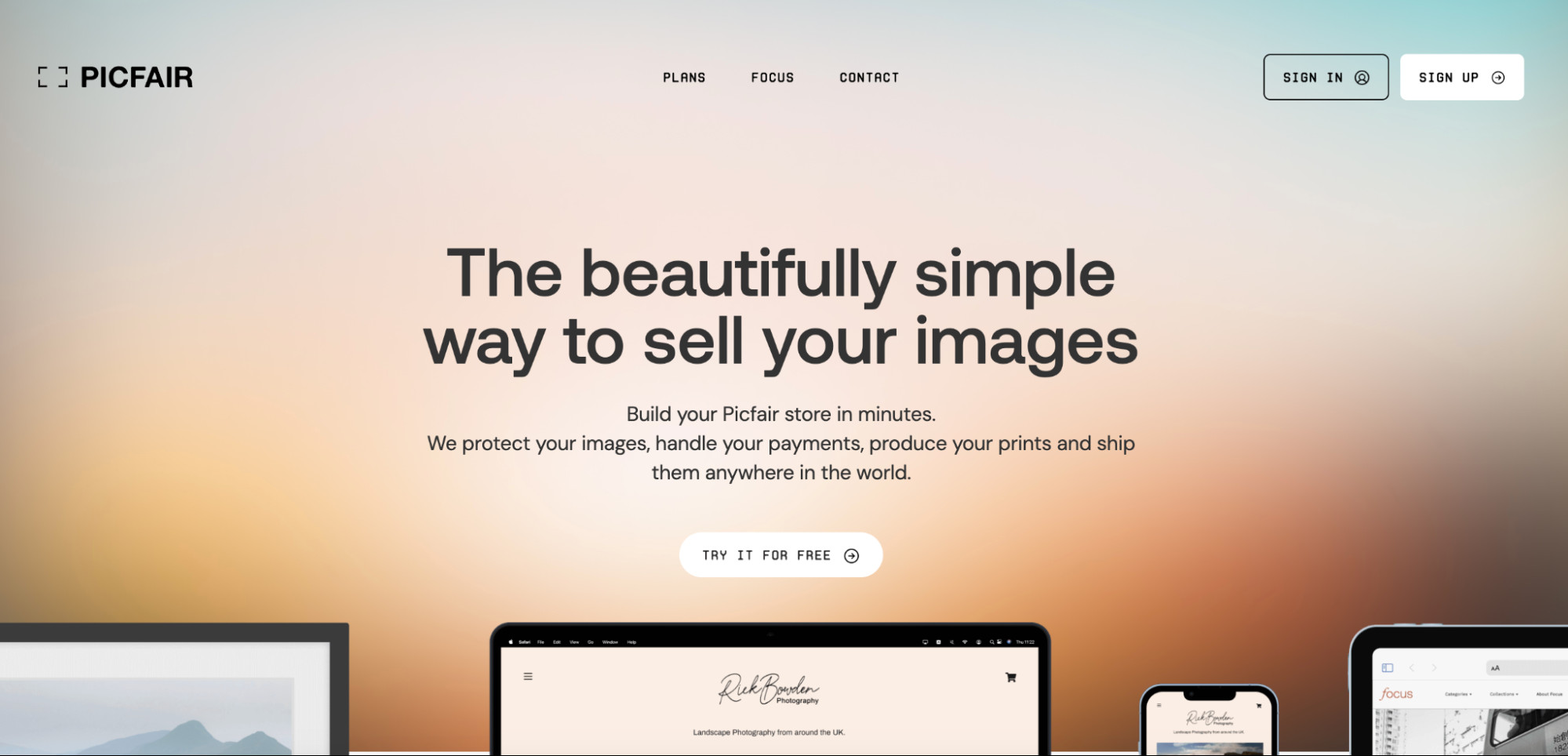 Picfair landing page for a website builder built for photographers.
Picfair landing page for a website builder built for photographers.
Key features:
- Control over pricing.
- Handles payment processing and print production.
How to get paid:
Sign up for a Plus plan, create a custom store, and sell images as prints or downloads.
1.8. Adobe Stock
Adobe Stock seamlessly integrates with Adobe’s popular photography software.
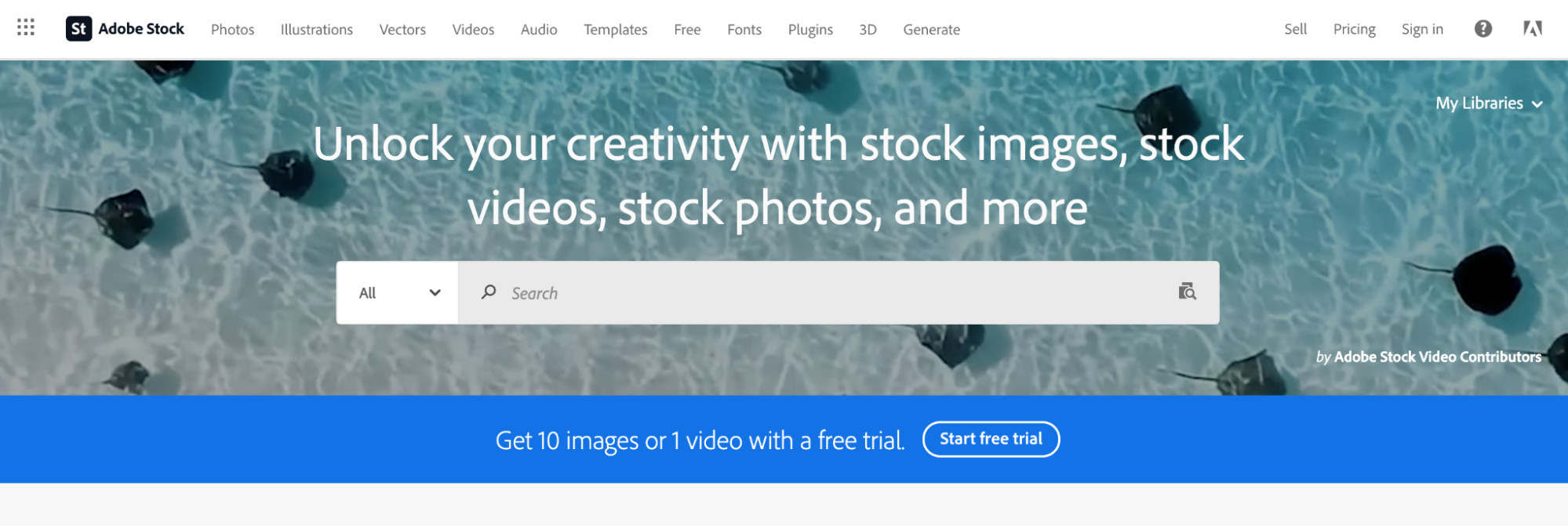 Adobe Stock homepage showing a search bar against a photo of sting rays in the ocean.
Adobe Stock homepage showing a search bar against a photo of sting rays in the ocean.
Key features:
- Integrates with Lightroom and Bridge.
- Upload assets directly from Adobe software.
How to get paid:
Contributors can earn 33% royalties on photos and 35% on videos.
1.9. Envato Elements
Envato Elements allows you to connect with potential clients and sell your photos online.
 Landing page for stock photos on Envato Market.
Landing page for stock photos on Envato Market.
Key features:
- Shares total subscriber revenue.
- Upload photos to your own site on the brand’s domain.
How to get paid:
Contributors earn between 25% and 50% of net subscription revenue.
1.10. Unsplash+
Unsplash is a free stock photo site owned by Getty, paying photographers for submitting images for specific assignments.
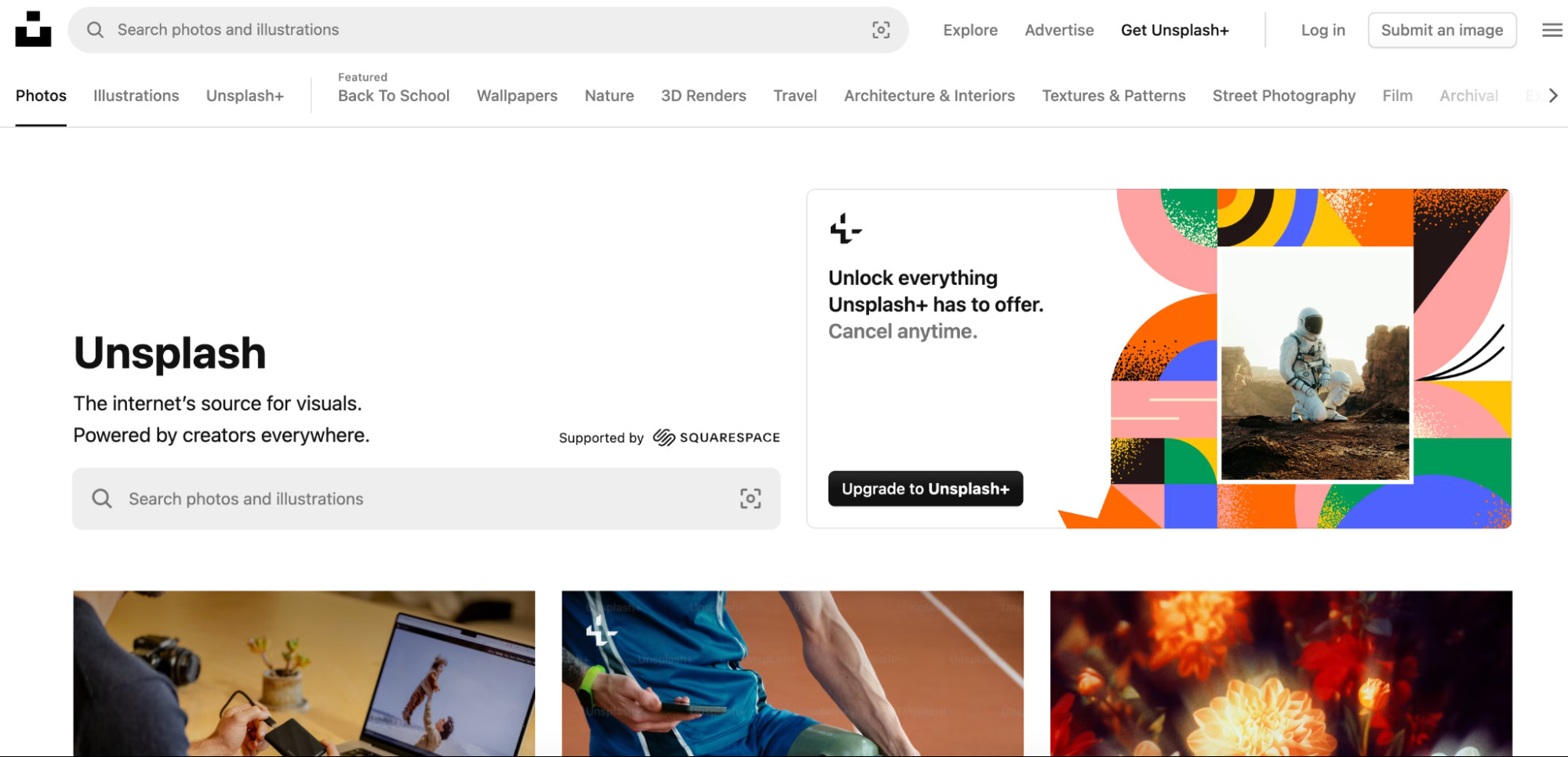 Unsplash homepage showing stock photos and a call-to-action for Unsplash
Unsplash homepage showing stock photos and a call-to-action for Unsplash
Key features:
- Partners with contributors through Unsplash+ program.
- Photographers respond to briefs and requests.
How to get paid:
Rates for photos range, on average, between $5 and $30 per image.
1.11. Dreamstime
Dreamstime offers a large, active audience with a huge range of royalty-free media, including stock photos, vectors, videos, and audio files.
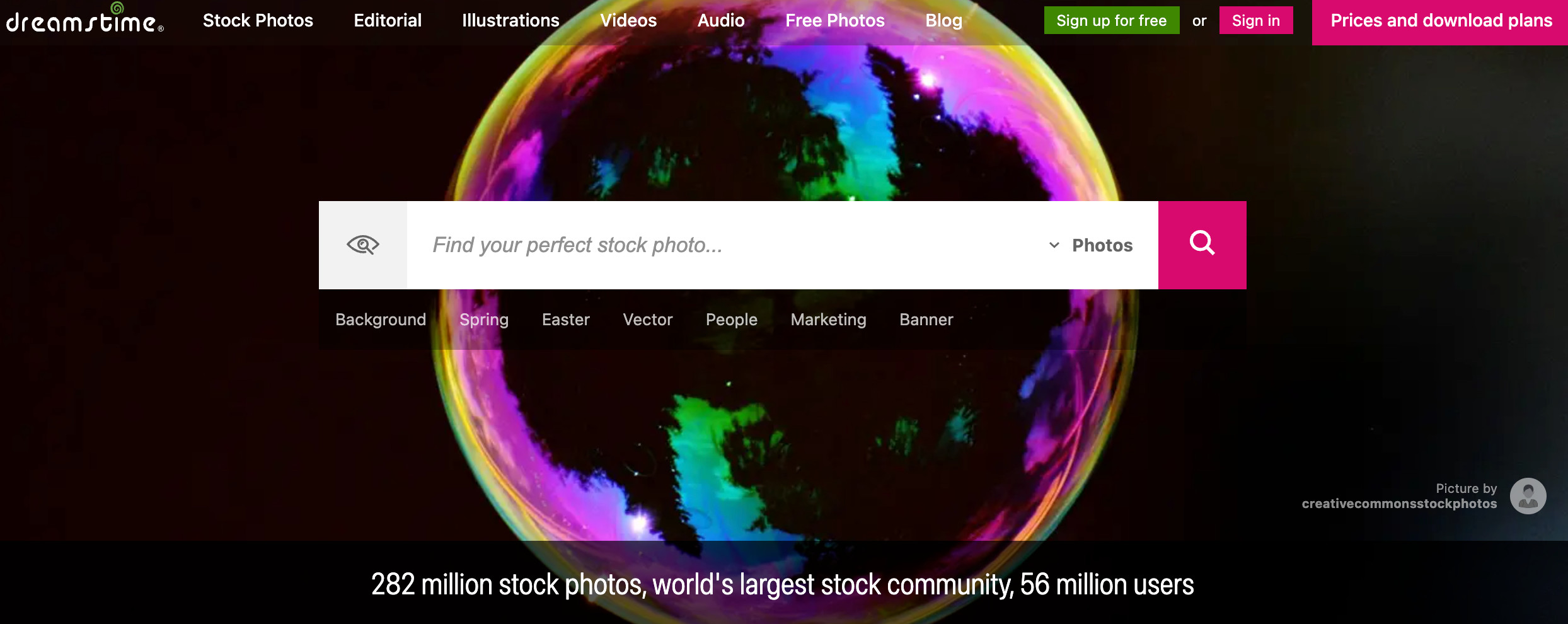 Dreamtime homepage where you can sell photos
Dreamtime homepage where you can sell photos
Key features:
- Library of over 250 million files.
- User base of over 50 million.
How to get paid:
Dreamstime offers revenue sharing of 25% to 50% for non-exclusive content. Exclusive contributors earn an additional 10% and receive 20¢ for each approved submission.
1.12. Snapped4U
Snapped4U is a marketplace for portrait and event photographers, allowing photographers to create personalized galleries and set their own prices.
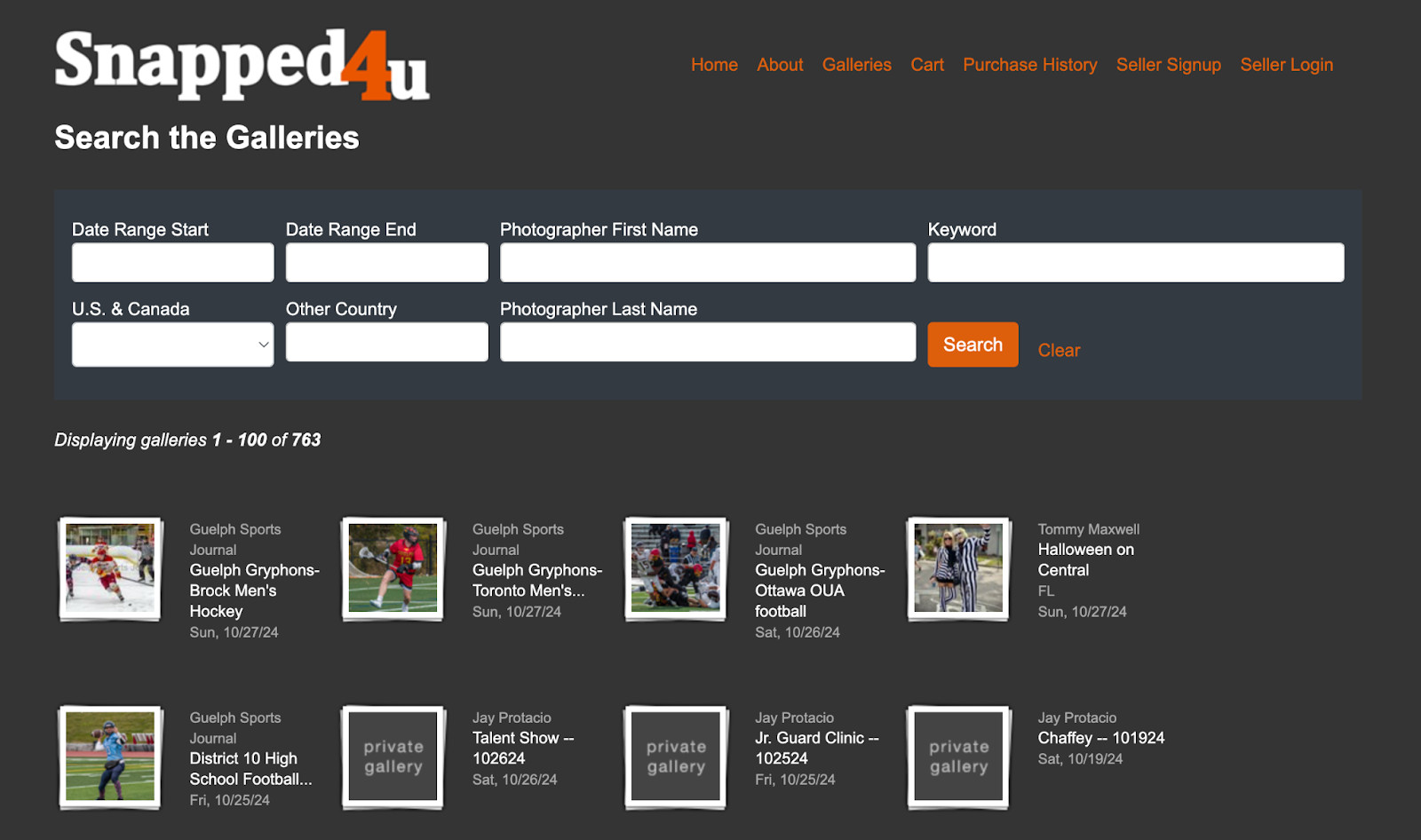 Snapped4U homepage showing photos from sports photographers
Snapped4U homepage showing photos from sports photographers
Key features:
- Specializes in portrait and event photography.
- Photographers create personalized galleries.
How to get paid:
Snapped4U charges a one-time $10 registration fee and retains a 10% to 12% commission on sales.
1.13. Foap
Foap allows photographers to sell commercial-quality images directly to brands and individuals.
 Foap creator landing page advertises a mobile app for photographers
Foap creator landing page advertises a mobile app for photographers
Key features:
- Photographers can participate in “missions” set by brands.
- Allows photographers to sell directly to brands.
How to get paid:
Mission payouts range from $100 to $2,000. Foap takes a 50% commission on all sales.
1.14. EyeEm
EyeEm combines a marketplace with a photographer community, inviting photographers to contribute to missions that call for images on a theme.
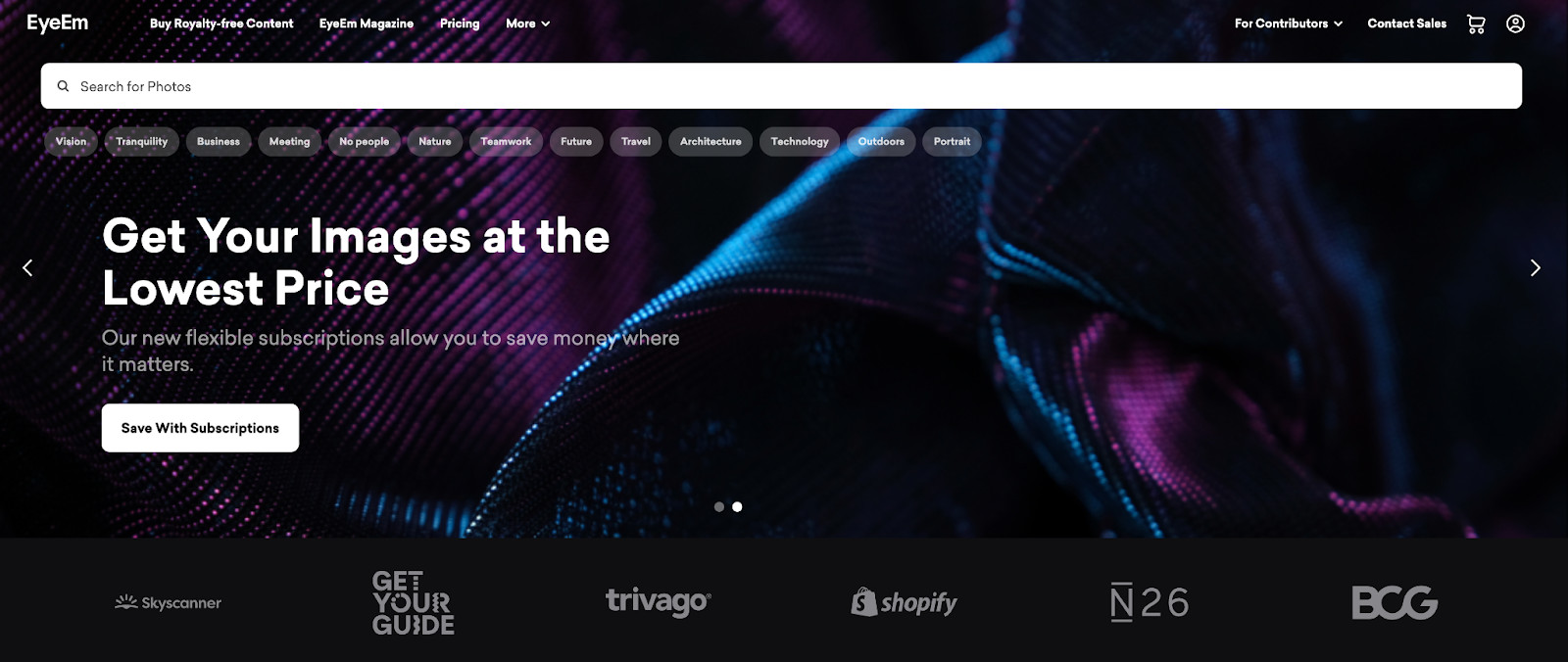 EyeEm homepage with a search bar and examples of high-profile clients
EyeEm homepage with a search bar and examples of high-profile clients
Key features:
- Combines a marketplace with a photographer community.
- Photographers contribute to missions.
How to get paid:
Contributors earn a 50% commission on each sale made through the EyeEm marketplace.
1.15. Pond5 (for videos)
Pond5 is a marketplace for selling royalty-free videos, music, sound effects, and other assets, frequented by major brand clients.
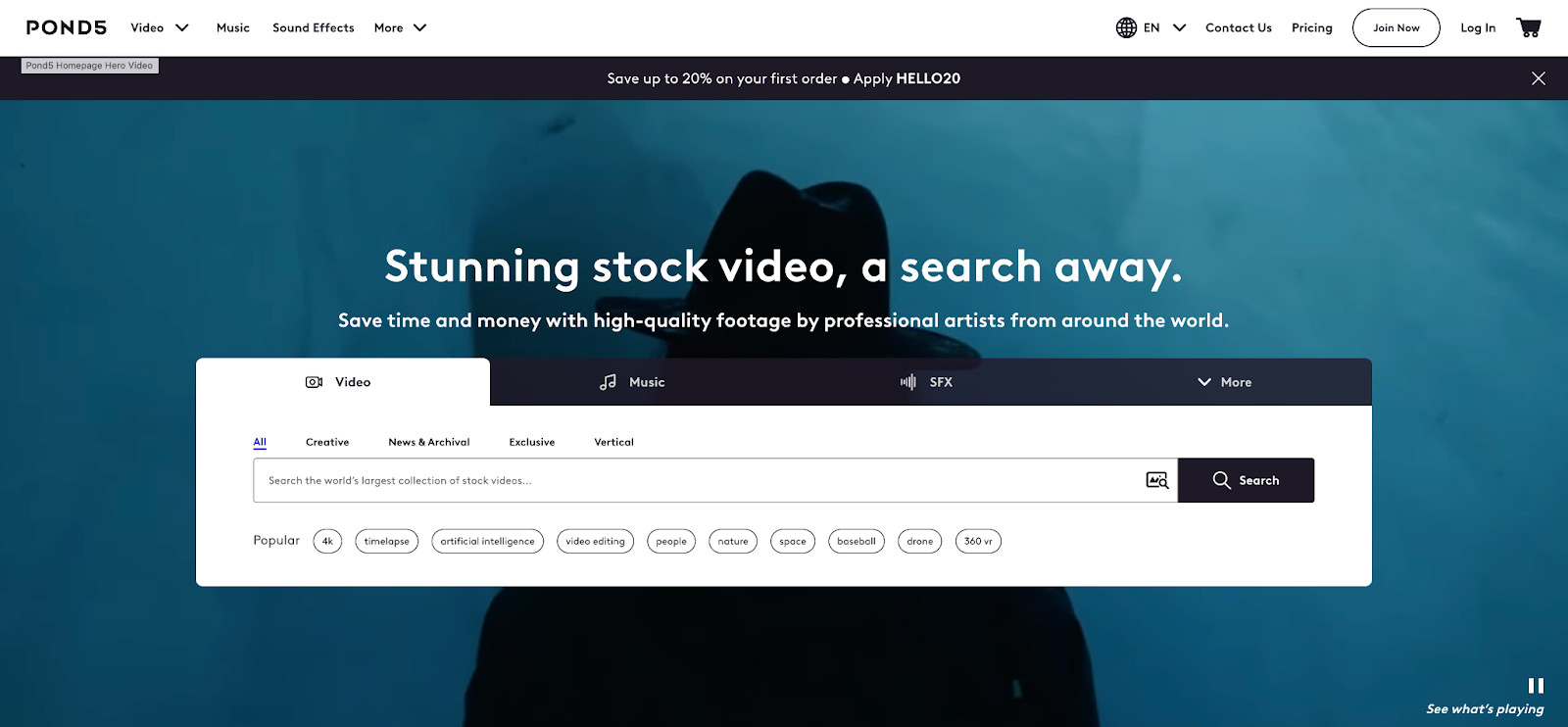 Pond5
Pond5
Key features:
- Marketplace for video content.
- Used by major brand clients like BBC and Disney.
How to get paid:
Video artists earn a 40% royalty share, with the option to make your content exclusive and earn up to 60%.
2. Tips for Selling Photos Online
To succeed in the world of online photo sales, consider these tips:
2.1. Define Your Stock Photography Niche
Consistency is key to attracting an audience. Focus on a specific style or theme in your photography, whether it’s travel, fashion, nature, or food. Evaluate the demand for topics using keyword research to analyze search volume for terms related to your photographs. According to research from the Santa Fe University of Art and Design’s Photography Department, in July 2025, a niche focus in photography is associated with a 30% higher rate of sales.
2.2. Get on Instagram
Building an audience is crucial for photographers. Use visual social platforms like Instagram to reach a wide audience. Use Instagram tools to engage with popular hashtags and grow a following of potential customers. Linking your social media accounts makes managing photo sharing across platforms easier and boosts visibility.
2.3. Integrate Ecommerce into Your Website
Most photographers have their own site to showcase their work. By adding a Shopify Buy Button to your site, you can make it easier for customers to purchase stock images from you.
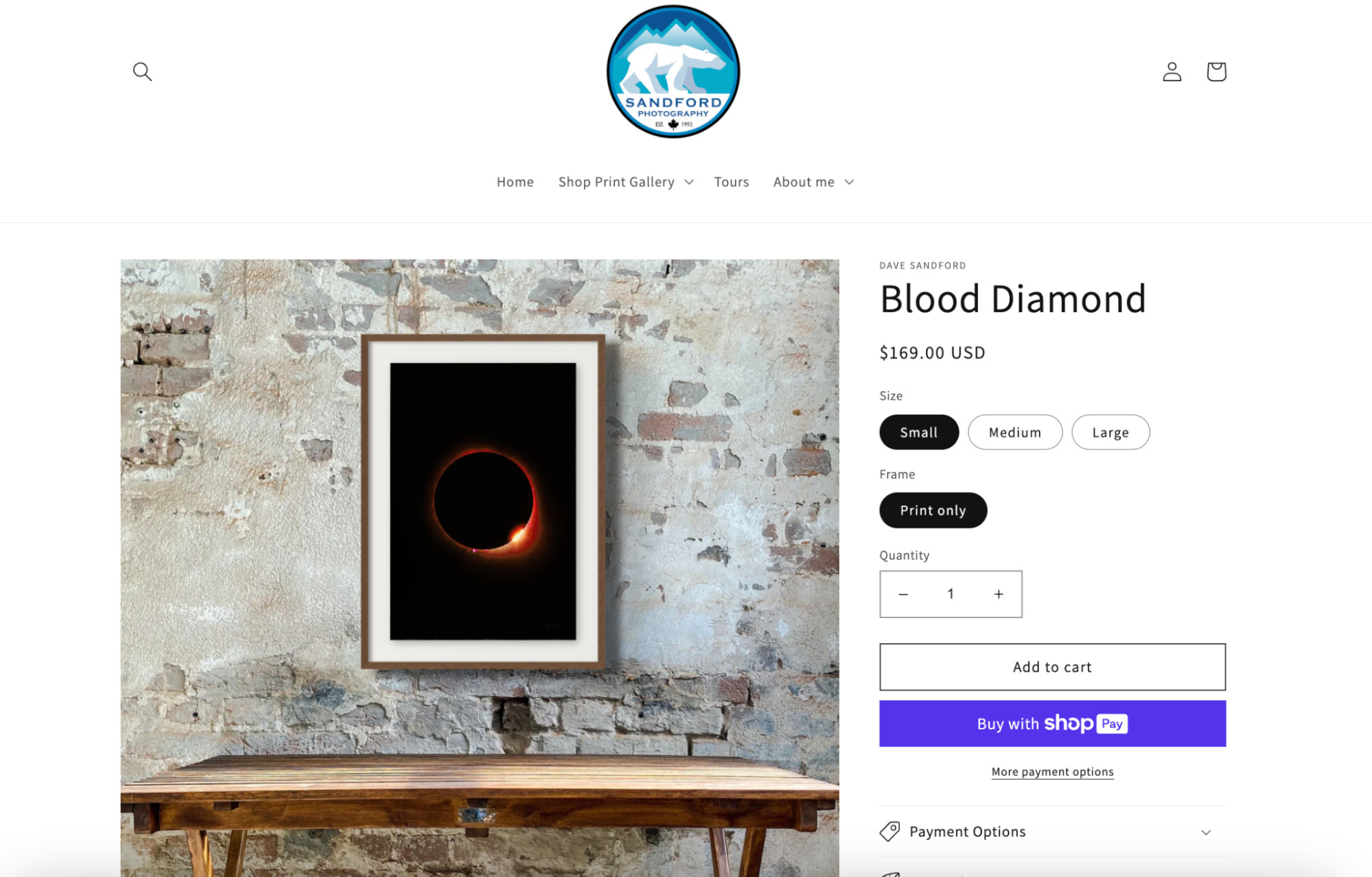 Product page for a print of a moon with a red border against a black background.
Product page for a print of a moon with a red border against a black background.
Dave Sandford’s store is an excellent example, showcasing his wildlife photography and offering prints and calendars for purchase.
2.4. Understand Your Market
Knowing your target market is essential. This involves understanding who they are, what they’re interested in, and what they’ll buy. For instance, if specializing in wedding photography, your target market might include wedding stationery brands or suit wholesalers.
3. How to Set Up Your Online Portfolio
Creating a professional online portfolio is a vital step in selling your photos.
3.1. Choose the Right Platform
The “best” platform depends on your goals and how much control you want over your imagery.
- Hobby/Passive Income: Stock photo submissions on sites like iStock or Alamy.
- Assignments from Brands: Apply to be an Unsplash+ contributor.
- Complete Control: An ecommerce platform like Shopify.
3.2. Plan Your Portfolio’s Structure
A portfolio is a photographer’s résumé. Pay attention to these elements:
- Layout: Photos should take center stage with context on what the image is about.
- Social Proof: Gather quotes from happy customers or showcase successful campaigns using your images.
- Categories and Organization: Keep everything tagged and organized for easy browsing.
- Gallery Size: Only include high-quality images that showcase your best work.
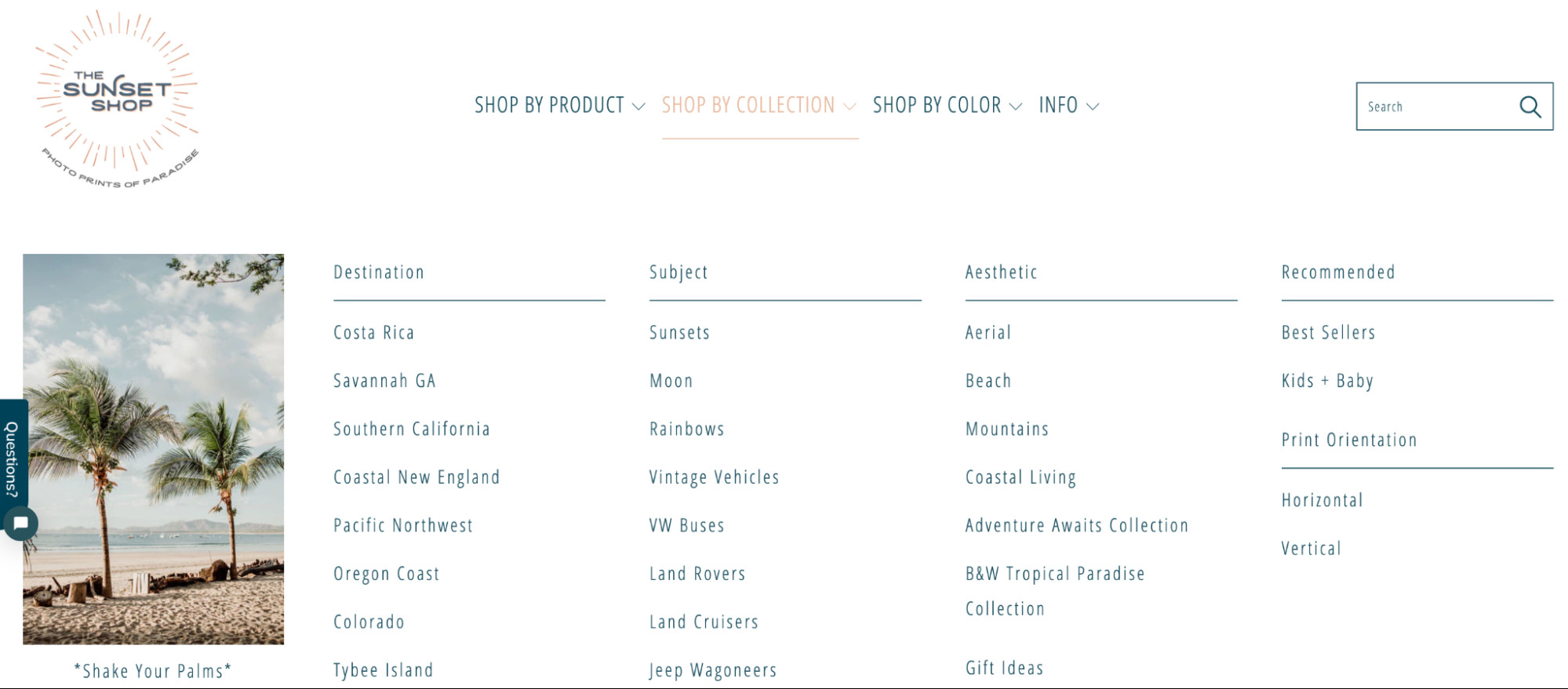 Example product categories on a photo print website include “Costa Rica”, “Sunset”, and “Mountains”.
Example product categories on a photo print website include “Costa Rica”, “Sunset”, and “Mountains”.
3.3. Optimize Images for the Web
Fast-loading images are essential for user experience.
- Compress Image Sizes: Keep images as small as possible without compromising quality.
- Use Descriptive File Names: Name your file descriptively, like “summer-evening-nature” instead of “IMG_3542.jpg.”
- Write Alt Text: Describe what your photo is about for search engines and screen readers.
3.4. Create an About Page
People buy from people, so include a summary of who you are and the story of your photography journey.
3.5. Implement Ecommerce Functionality
An ecommerce platform like Shopify handles the logistics of selling photos online, including payment processing, shipping, and marketing.
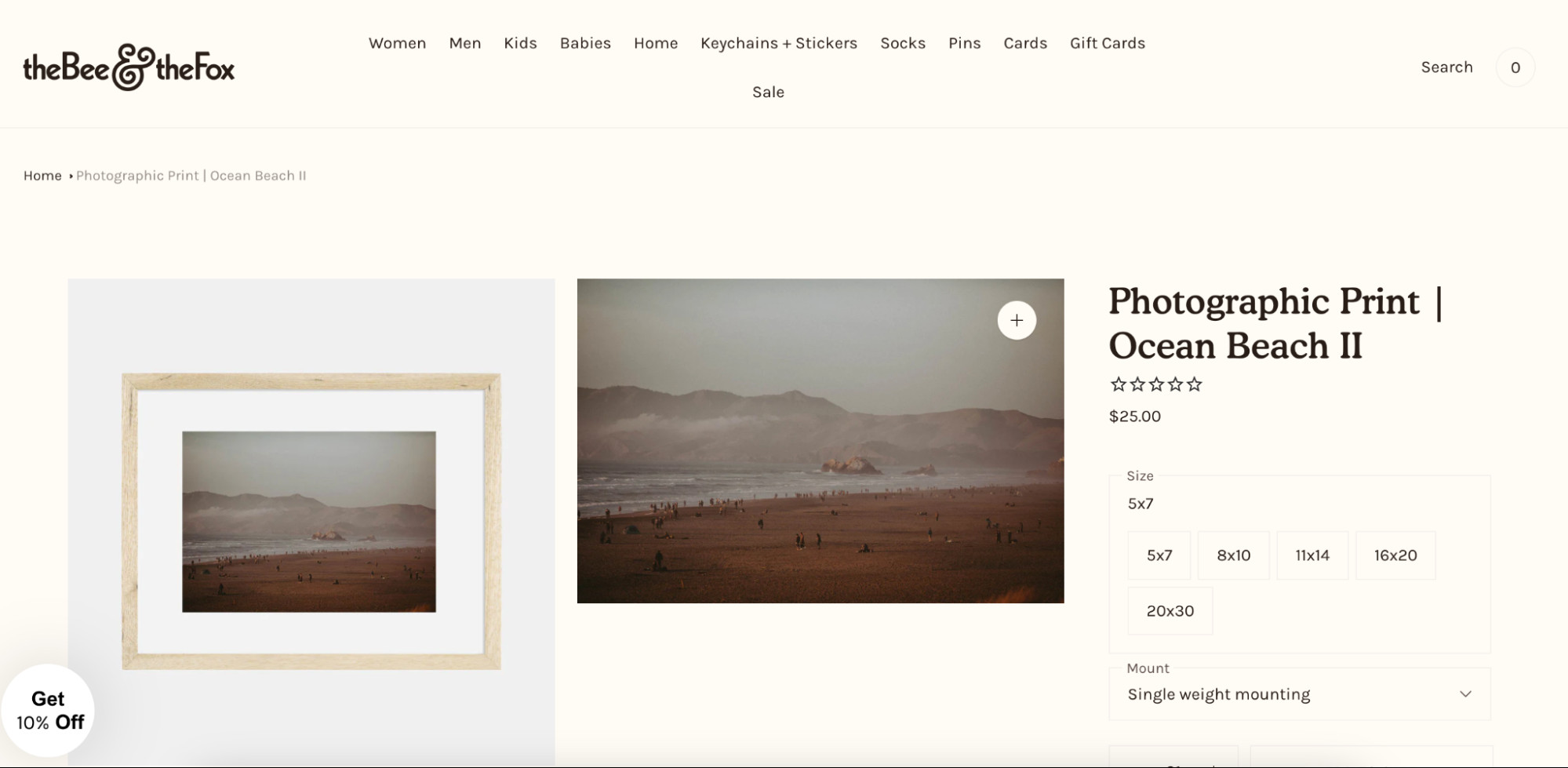 Product page for a 5×7 printed photo of a beach.
Product page for a 5×7 printed photo of a beach.
3.6. Ensure Mobile Compatibility
With more than half of global website traffic happening on mobile devices, ensure your portfolio looks good on smaller screens.
3.7. Launch and Promote Your Photos
Share your portfolio link online using marketing tactics like social media, Pinterest, influencer gifting, and email lists.
4. How to Sell Photos as Prints and Photo Books
Selling physical products like prints or photo books can provide additional income streams.
You can make money selling photos as prints or physical products, such as mugs, t-shirts, and calendars. Popular sites and tools include:
The best way to sell photos online as physical prints or products is to work with a local photo lab that helps you ship and sell prints, or use a print-on-demand company to dropship a wide range of products (prints, phone cases, pillows, and more) featuring your photos.
Be sure to order samples first to ensure the quality of the products match the quality of your photos.
4.1. How to Sell Photography Online as Photo Books
Photo books are another physical product that can feature your photography.
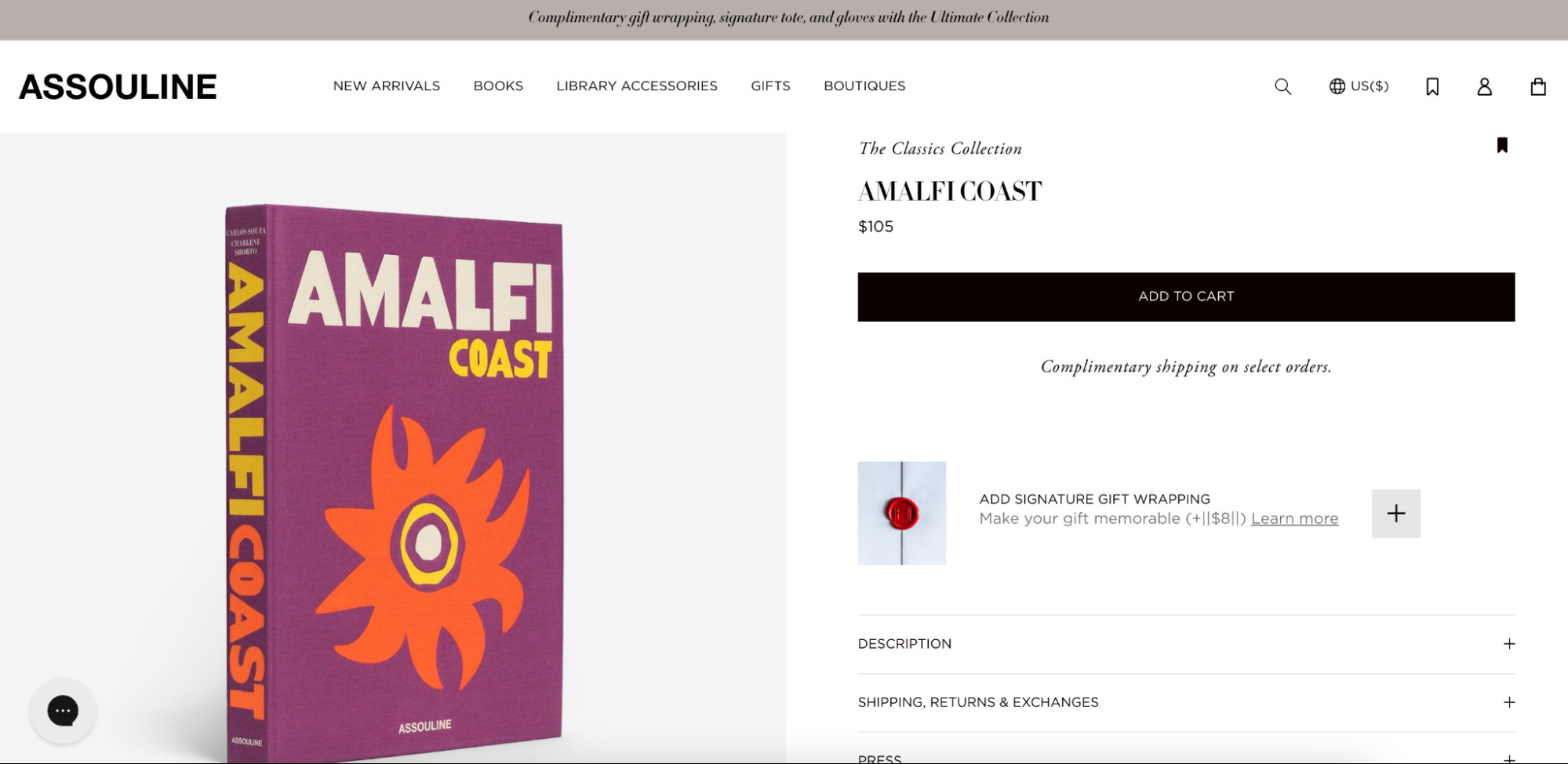 Photobook of images taken on the Amalfi Coast.
Photobook of images taken on the Amalfi Coast.
5. How to Sell Your Photography Services
There are plenty of business opportunities available for professional photographers, whether you’re covering events, doing fashion shoots, or getting into product photography.
Networking is crucial for selling your photography as a service:
- Business Cards: Always have business cards handy.
- LinkedIn Profile: Optimize your LinkedIn profile to showcase your work.
- Networking Events: Attend events where entrepreneurs and event organizers attend.
- Personal Brand: Regularly share your work on social media.
Since photographers must operate in strict time slots, it’s good to have a booking platform you can use to let prospective clients see your schedule and book you when you’re available.
6. Pricing Strategy for Selling Photos Online
Here’s how to decide on a pricing strategy for your photography business:
- Market Research: Ask your target market how much they’d pay for your photos and see how much comparable photos sell for on stock image sites.
- Profit Margins: Consider the costs of photography, like any equipment, website hosting fees, and marketing budgets.
- Different Prices for Usage: An exclusive photo can sell for a lot more money than a non-exclusive one.
- Offer Discounts: Whether it’s a first-time customer or a loyal fan that you’re rewarding, experiment with discounts and promotions that incentivize people to buy your photos.
- Product Bundles: Instead of selling one photo, sell a collection of related images at a discounted price.
7. Legal Primer for Selling Your Photos Online
Here’s a glossary of legal terms to help protect yourself when selling photos online:
- Editorial Use: Permission to use in blogs, newspapers, magazines, and other publications.
- Commercial Use: Permission to use in marketing and advertising to promote a product or service.
- Retail Use: Permission to use in the creation of a physical product to be sold.
- Exclusive Use: The one who purchases the license from you is the only one who can use the photo.
- Non-Exclusive Use: Photo licenses that can be purchased and used by anyone and usually cost less than exclusive ones.
- Public Domain: When photos have no restrictions or copyright claims and can be used for commercial, editorial, and personal purposes.
- Creative Commons: Conditional usage of your work is allowed, as long as it’s in compliance with the stated restrictions.
- Royalty Free: Others can buy a license and use the photo for an unlimited duration and unlimited number of times.
- Rights Managed: A one-time license can be purchased to use the photo with restrictions regarding distribution.
- Right of Publicity: The subjects in your photos are entitled to certain rights when it comes to their inclusion in your photography, especially when it comes to commercial use when you sell photos online.
7.1. What to Do If Someone Steals Your Photos
Theft is common concerning content, and many people do it unknowingly.
Photographers can watermark their digital images before selling them online to protect against theft. If you sell or share your photos, you can apply identifying marks in Photoshop or use a watermark generator.
A smaller watermark, often in the corner, will less impact your photo, while a larger watermark with reduced opacity offers the most protection against theft.
But what do you do if someone steals and uses your photos anyway? A cease and desist request usually will work. Or you can send the culprit an invoice for using your photo. Combining the two will likely be the most effective at persuading the perpetrator by offering them the choice to either pay you or take the photo down.
At the very least, you should always try to get others to credit you whenever they use your work, even for editorial purposes. Remember that backlinks to your portfolio site are useful for driving traffic to your other work and for search engine optimization and helping your standing in Google search results.
How to Sell Photos Online FAQ
What Is the Best Way to Sell Photographs?
Selling them as stock images for sale on third-party websites like iStock, Shutterstock, or Alamy is generally the best approach. It’s quick, easy, and affordable.
Where Can I Sell My Photos Online for Money?
You can sell your photos on platforms like Alamy, 500px, Shutterstock, Getty Images, iStock, Stocksy, Picfair, Adobe Stock, Envato Elements, and Unsplash.
How Do You Make Money From Stock Photography?
A stock photography website sells high-priced and exclusive images that you upload. The agency licenses individual images to the client and sells them for a set price. Then you, the photographer, get a royalty payment.
Ready to take your photography to the next level? Visit dfphoto.net for more resources, inspiration, and a vibrant community of photographers. Explore our detailed guides, discover stunning photography, and connect with fellow enthusiasts. Don’t just capture moments, turn them into opportunities. Address: 1600 St Michael’s Dr, Santa Fe, NM 87505, United States. Phone: +1 (505) 471-6001. Website: dfphoto.net.

